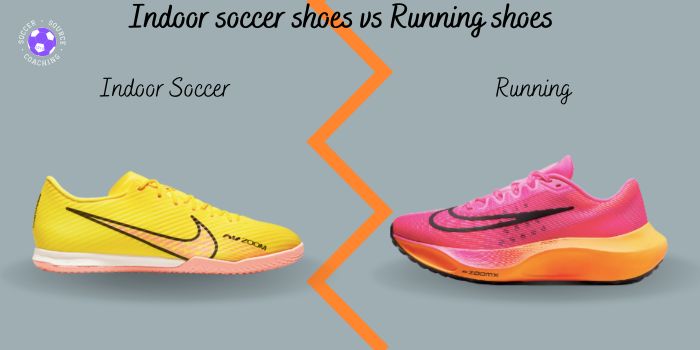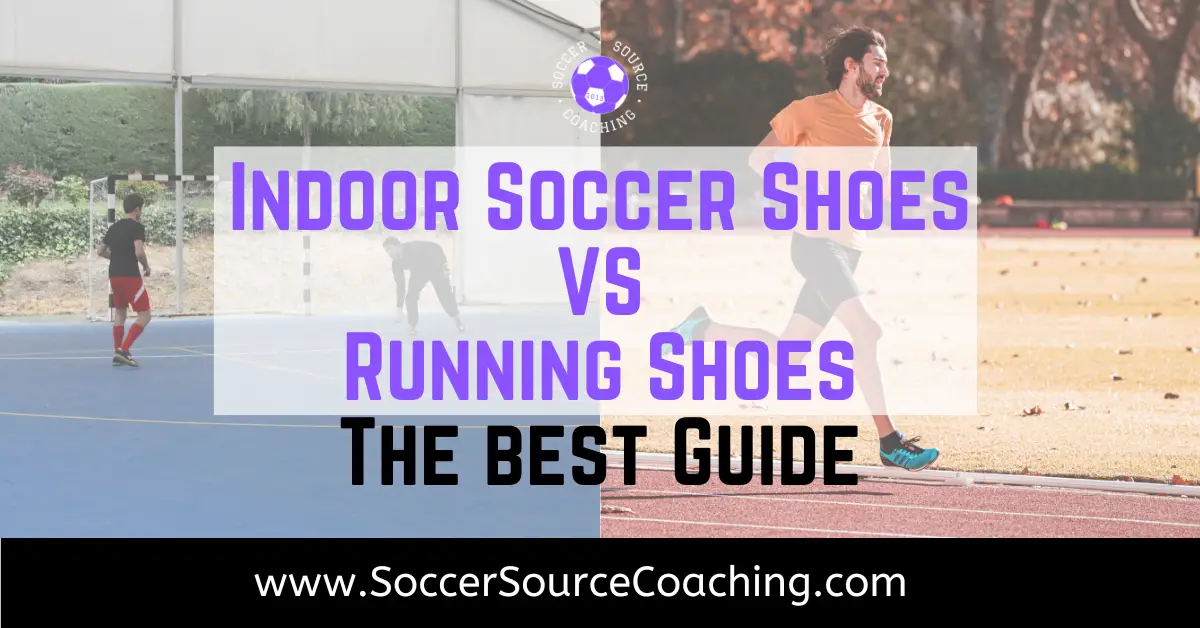For soccer players, indoor soccer (futsal) provides a good option to play during the regular or off-season as it is played on a hardwood surface. However, not all athletes will own a pair of indoor soccer shoes but have running shoes instead, but can they be used? This indoor soccer shoe vs running shoe guide will compare the shoes and whether they can be used for either activity.
Indoor Soccer Shoes Vs Running Shoes | Quickly Summarized
Selecting the right type of shoe for your futsal or running is crucial to avoid injury and improve performance.
Futsal shoes are a great option for indoor soccer.
They feature a low or mid-cut profile, a non-marking rubber sole, and a lightweight synthetic or leather upper.
These shoes offer excellent lateral support and better grip and traction on the hardwood floor.
Equally, running shoes are perfect for running activities, offering flexibility, moderate to high cushioning, and moderate lateral and ankle support to avoid running-related injuries.
However, it’s essential to keep in mind that indoor soccer shoes may not provide enough cushioning and traction on various surfaces for extended running or walking periods.
Also running shoes may not be the best option to play indoor soccer.
The bulky cushioned midsole and mesh upper are not designed for kicking a soccer ball and the sole of the shoe, won’t provide the best traction for hardwood surfaces.
So, selecting the appropriate type of shoe for either running or futsal is important to prevent injuries and enhance performance.
The difference between indoor soccer shoes and running shoes

The table below will help you quickly distinguished the differences between indoor soccer (futsal) shoes and running shoes:
| Feature | Indoor Soccer Shoes | Running Shoes | Purpose |
|---|---|---|---|
| Design | Low-cut or mid-cut | Low-cut or mid-cut | Indoor soccer shoes have a lower profile design to allow for quicker movements and agility. Running shoes have a low-cut design to provide flexibility and range of motion during running activities. |
| Sole | Non-marking rubber | Rubber or synthetic | Indoor soccer shoes feature a non-marking rubber sole to provide grip and prevent slipping on an indoor court surface. Running shoes will use different types of rubber or synthetic materials for use on multiple surfaces. |
| Upper Material | Lightweight synthetic or leather | Synthetic or mesh | Indoor soccer shoes are manufactured with lightweight synthetic materials or leather to provide flexibility and breathability. Running shoes typically use synthetic or mesh materials for durability and support. |
| Traction | Designed for quick, multidirectional movements | Designed for forward movement | Indoor soccer shoes use patterns on the sole that allow quick movements and sudden stops on indoor surfaces. Running shoes feature traction patterns that provide grip and stability during running activities. |
| Cushioning | Minimal | Moderate to high | Indoor soccer shoes usually use little cushioning to provide a closer feel to the court. Running shoes use moderate to high levels of cushioning to absorb the impact of running activities. |
| Fit | Snug and form-fitting | Snug and form-fitting | Both indoor soccer shoes and running shoes are designed to have a snug, form-fitting fit to provide stability and support during gameplay/running. |
| Breathability | Good | Good to excellent | Both indoor soccer shoes and running shoes typically have good to excellent breathability to prevent overheating and moisture buildup. |
| Support | Good lateral support | Moderate lateral and ankle support | Indoor soccer shoes typically provide good lateral support to allow for quick movements and changes in direction. running shoes provide moderate lateral and ankle support to protect against injuries that can occur during running activities. |
Frequently asked questions about futsal shoes and running shoes
These are the most commonly asked questions when it comes to indoor soccer shoes and running shoes
Can I use running shoes for indoor soccer?
While you are able to wear running shoes for indoor soccer, it is not recommended.
When compared to indoor soccer shoes, running shoes lack the appropriate level of support needed to safely make sided-to-side movements and sharp turns.
The thick sole and mesh upper of running shoes makes it a lot harder to control, pass, and strike the ball properly.
The bottom of running shoe soles is not specifically designed for the hardwood surface of indoor soccer (futsal) either.
These factors significantly increase the chance of the athlete slipping and injuring themselves.
As well as, hindering your own performance and increasing your chance of injury by wearing running shoes for indoor soccer, you will also ruin your running shoes!
They were not designed for the constant kicking and striking of a soccer ball.
If you are looking to play indoor soccer it is advisable to avoid wearing running shoes and put on a pair of indoor soccer shoes.
Can I wear indoor soccer (futsal) shoes for running?
Yes, it is possible to wear indoor soccer (futsal) for running but is not recommended.
While indoor soccer shoes provide great movement and flexibility for short sprints on a hardwood surface, they are not great at providing support for extending running periods on a variety of outdoor surfaces.
One of the biggest flaws of wearing indoor soccer shoes for running is the small amount of cushioning it has.
This puts a lot more stress on the knees and ankles to absorb the pressure from running, as well as making the athlete more likely to get an ankle injury from running on uneven surfaces.
The sole of the running shoe is also designed to be used on a variety of surfaces, as where the gum sole of the indoor soccer shoe should only be used on hardwood floors.
Not only will this reduce your traction on different surfaces and make running more dangerous, but it will also ruin the sole of your indoor soccer shoe.
This can then negatively affect your indoor soccer performance and not give you the necessary grip on the hardwood surface to meet the demands of the sport.
Are running shoes good for indoor sports?
While running shoes are incredibly comfy and a great choice for running, they are not a good option for indoor sports.
Running shoes provide excellent stability and traction for forward motion, but they do not support athletes who need to make short, fast, lateral movements common in indoor sports.
One of the main features of indoor shoes that running shoes do not have is the non-marking rubber outsoles.
This provides the athlete with better grip and traction when participating in indoor sports.
Wearing running shoes for indoor sports can increase the chance of the wearer picking up an injury and ruining their running shoes.
Are indoor soccer shoes good for walking and wearing as a sneaker?
Yes, indoor soccer shoes can be good for walking and wearing as a sneaker replacement.
However, these are the factors you need to take into consideration:
- The length of time you are walking
If you are walking for less than 30 minutes at a time then, indoor soccer shoes should be fine.
Walking for greater than 30 minutes may start to cause some discomfort in the foot, ankle, or knees due to the little amount of cushioning in the sole.
- The surface you are walking on
If you are walking on a relatively flat or smooth surface then an indoor soccer shoe will be good!
However, if you are walking on uneven, off-road, or wet surfaces then consider wearing running shoes or a more appropriate sneaker
- Understand that walking in your indoor soccer shoes can ruin them
If you are using indoor soccer shoes for walking or as sneakers, try to make sure they are an old pair
Indoor soccer shoes are specifically designed for playing indoor soccer and walking.
This means that the non-mark rubber sole can get damaged and can hinder your indoor soccer performance.
Best indoor soccer shoes for futsal and running
If you play futsal and looking for an indoor soccer shoe that you could use for occasional running I recommend the Adidas Predator Tango 18.3 Indoor Shoe.
If you are looking at buying soccer cleats and don’t know where to start this is a comprehensive soccer cleats buying guide to make the process simpler.
This is the best buyers guide for running shoes
Adidas Predator Tango 18.3 Indoor Shoe

>> Check Prices <<
These are my reasons why:
- Lightweight materials
Both of these indoor soccer shoes are made of lightweight, breathable materials, which provides comfort while running or playing futsal
- Cushioned support
This futsal shoe has a cushioned midsole that can improve shock absorption for both futsal and running, even though indoor soccer shoes are not known for their cushioned midsole.
- Ankle support
To help support the ankle this Adidas model has a sock to fit around the ankle to help it stay in place while playing futsal or while running.
Final thoughts and recommendations
As a whole, I would recommend using the corresponding footwear for the activity you are participating in.
This can largely reduce your risk of injury and improve the longevity of your footwear.
However, if you are looking to wear indoor soccer shoes for running or running shoes for indoor soccer these are the considerations you need to make:
The frequency you run and play indoor soccer (futsal)
If you are someone who frequently runs and plays indoor football then it would be in your best interest to have a pair of running shoes and futsal shoes.
Even if you take one of the activities seriously I would recommend getting a separate pair too.
This is because you can damage your footwear if you are not using it for the intended purposes, which can negatively impact your performance and increase your risk of injury.
If you are someone who occasionally runs and plays indoor soccer then wearing either footwear would be an ok choice.
Injury history
If you are someone who has had previous feet, ankle, or knee injuries then I would recommend that you wear the appropriate footwear for each sport.
Running shoes have a specifically designed, cushioned midsole that can help lessen the impact on the ankles and knees while running, as where futsal shoes have a very little padding in the midsole.
Indoor soccer shoes also have a specialized sole made of non-mark rubber, which helps maintain grip and traction while making shape changes of direction.
Running shoes do not have this feature, as they were primarily designed for forward motion.
If you have persistent injuries from either running or futsal make sure to consult your doctor if you are unsure how your footwear can affect you.
Personal preference
This ultimately comes down to the athlete’s choices and what they feel comfortable wearing.
Athletes need to make the best choice for themselves, in terms of comfort, performance, and injury risks.
Hopefully, this indoor soccer shoes vs running shoes guide has given you a better understanding of the differences, benefits, and questions around the topic.
Thank you for reading and please share this guide with any athletes or parents who are in this dilemma.
Toby.
Wearing soccer cleats and shoes for other sports
If you found this indoor soccer shoes vs running shoes guide helpful you would also gain knowledge from similar posts:

